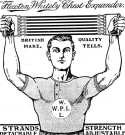
In June, Sheila and Peter Harris and I went up to Daventry in Northamptonshire to keep our appointment with Mr. I. Green, Managing Director of Whitely Products Ltd., former occupants of Ravensbury Mill. We had asked to be allowed to see their archives, in order to help us to set up a display on Ravensbury Mill.
Mr. Green produced several boxes of old papers and worked his way through them, showing us anything of interest. He gave us a substantial pile of material which he said we could keep, and arranged for photocopies of several other photos and documents. Altogether he spent about two and a half hours with us, and said that he had had an interesting morning.
Among these archives are several brochures and advertisements for their sports and fitness products. One brochure contains photos of ‘Ravensbury Lil', a secretary who was persuaded to model the equipment.
There are several documents from the River Wandle Protection Association, mostly reports and minutes of meetings, and among the names of the committee is that of Colonel Bidder .
One of the most interesting items is a small expenses book dated 1851, which belonged to a Rutterts salesman. Rutter was the previous tenant of the mill and produced snuff.
| [Full size image 41kb] |
These archives are in the process of being catalogued and will help greatly to provide information for an exhibition.
The following brief history of Whitely Products was transcribed from copy of notes donated by Mr.Green, Manager at Daventry
WHITELY PRODUCTS LTD:
The firm was founded in 1894 as a subsidiary of Whitely Excerciser Company of U.S.A. (which still exists) and further works were opened in Germany which closed in 1914.
| [Full size image 103kb] |
Mr. Whitely withdrew in 1904 and it became an entirely British company, trading extensively in Europe and other parts of the world. Its best known salesman was Eugen Sandow who was known for years as the strongest man in the World, and is still a legend in the strong-man world. Mr. Sandow was born in Germany in 1867 was a wrestler, world champion weight-lifter and renowned physical culturist; and he later opened his own factory in France. Elastic cords or bungees as they are sometimes known, became known in France as Sandows, and this name is still in general use there. Resulting directly from this the French industry in this product provided the severest competition. Ironica1ly the rights in Britain of the name 'Sandow' for a chest developer was sold to a rival British firm and is still in use.
The interest in aircraft came with the experimental stringbags of 1908 onwards, and such names as Mr. A. V. Roe (now Hawker Siddley) of Manchester, and Mr. Saunders (now Br Hovercraft Corp) of Cowes were Customers, as was M. Bleriot of channel crossing fame.
The British family maintained control of the business until 1963, still pursuing the main outlets to the sports and aircraft trades. It was then sold to the current directors, who continued these outlets but extended them. The well known Luggage Elastic was first produced in Northampton by assembling ready made cord and end hooks.
Mr. N. Green whose firm had made leather webbing straps and fittings for the cycle and allied trades since 1906 obtained the idea by seeing ex-servicemen use ex- WD aircraft bungees in motorcycles. Great difficulty was experienced in marketing this expanding strap as no trader would accept this unknown method of fastening luggage and would not trust it, but nevertheless a slow impression was made in the late 40s as an aircraft quality product.
| [Full size image 31.9kb] |
Cooperation in developing new outlets and fittings continued however with the old Leicester firm of Luke Turner, who were the original suppliers to Mr. Green, and after several take-overs of this Leicester firm, (finally to within the Courtauld Group) the Leicester factory was closed, Shock Absorber Cord discontinued, this now being incorporated into the Whitely Products Ltd., organisation.
This meant that the combined specialised outlets of three firms has resulted in a wide range of industry being supplied with broader elastic cords in a considerable variety of diameters, strengths, stretches and fittings. This is completely opposed to the normal concept of business today of rationalisation of product and its consequential limitation of customers range, or a range of products to one class of outlets. However the importance of and use of many of the products justifies the continuance of specialist producers, although the imposed limitation of outlets on quality means that viability may be only achieved by export to countries where a local similar industry could not be justified. This generalisation is true of both elastic cord and its essential inner core, rubber thread.
[Editors note, November 2001. The reference to skipping ropes is an interesting, if tenuous, connection with the Museum. Founder member and past Chairman, Harry Galley, was recently in the news. On 10 October 2001 the Daily Mail reported on the progress his company is making in re-introducing the art of skipping into our schools, inspired by the British Heart Foundation's Jump Rope Campaign]
|
|
|
|